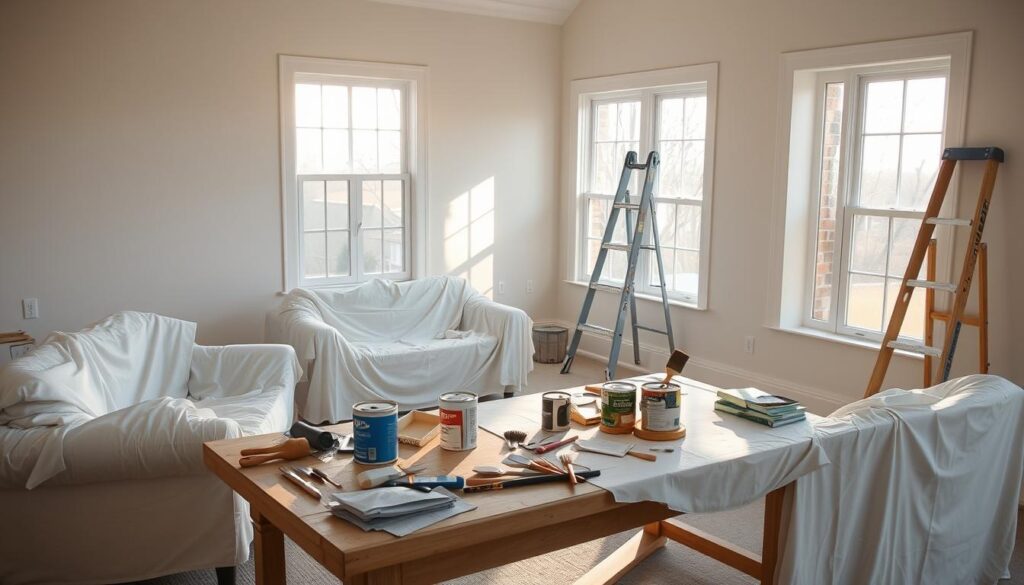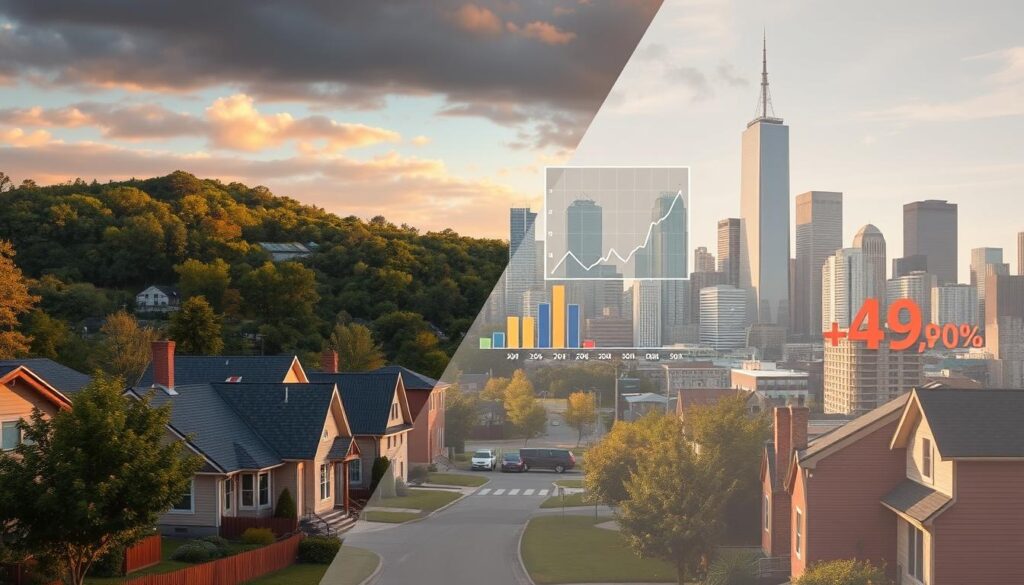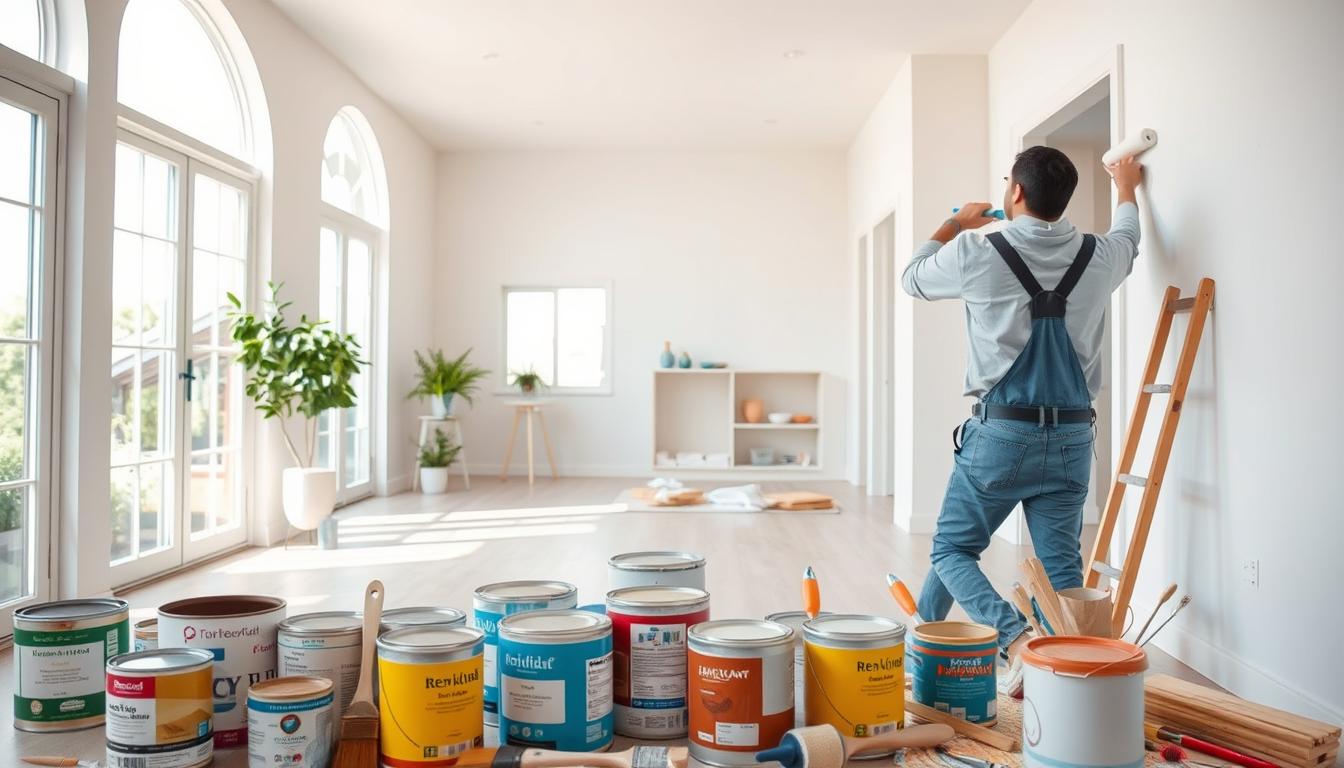Did you know a fresh coat of paint can change your living space? The average cost to paint a home’s interior is about $2.75 per square foot. This price goes up to $4.69 per square foot when you add walls, trim, and ceilings. This big investment can really change your home’s look.
Understanding the costs involved is key for planning and budgeting. Many things can change the final price, like your home’s size and the paint type. We’ll look at these factors to help you get ready for your painting project.
Key Takeaways
- Average cost per square foot for interior painting is $2.75.
- Including walls, trim, and ceilings, the cost increases to $4.69 per square foot.
- Several factors can affect the overall cost of your interior painting project.
- Understanding these factors can help you better plan and budget.
- Choosing the right paint and materials is crucial for the outcome.
Understanding Painting Costs: An Overview
Many things affect the cost of painting your home’s inside. Knowing these factors helps you get a precise estimate.
Average Cost Per Square Foot
The cost to paint your home’s interior is based on its size. This cost can vary from $2 to $6 per square foot. It depends on the job’s complexity and the paint used.
Factors Influencing Painting Costs
Several key factors affect the cost of painting your home’s interior. These include:
- The height of your rooms, as taller rooms require more paint and may need special equipment.
- Ease of access to the areas that need painting, as difficult-to-reach areas may require additional labor or equipment.
- The condition of the walls, as damaged walls may need repair before painting.
Using a painting cost calculator can help you estimate the cost to paint your interior more accurately. It considers these factors.
Breakdown of Expenses in Interior Painting
Homeowners often wonder what makes up the total cost of interior painting; let’s examine the key expenses involved.
When planning an interior painting project, it’s crucial to understand the various costs involved. The total expense is mainly split into two parts: the cost of paint and materials, and labor costs.
Price of Paint and Materials
The cost of paint and materials is a big part of the total expense. The price of paint can vary a lot. This depends on the quality, brand, and type. For example, premium paints with mold resistance or low VOC are pricier than standard ones.
Other materials like brushes, rollers, trays, and drop cloths also add to the cost. Even though they might seem small, they can add up, mainly for bigger projects.
Labor Costs: What to Expect
Labor costs make up most of the professional painting expenses. They cover more than just painting. Prep work can take a lot of time, like if the walls are dirty or have old wallpaper.
When you hire a professional painter, labor costs include:
- Surface preparation (cleaning, sanding, filling holes or cracks)
- Removing old paint or wallpaper
- Taping off trim and other areas not to be painted
- Applying the paint
- Cleanup and disposal of materials
Knowing these parts helps homeowners estimate the total cost of their painting project. It helps them make better budget decisions.
Types of Interior Paint: Cost Differences
Choosing the right paint for your interior can affect your budget. There are many paints out there, each with its own price tag. It’s important to know how much each type costs.
Affordable vs. Premium Paints
When deciding between affordable and premium paints, think about durability, finish, and coverage. Affordable paints are cheaper but might need more coats. This could raise labor costs. Premium paints, on the other hand, last longer and cover better, saving money in the long run.
If you’re on a tight budget, look into affordable interior painting options. But for big projects or a fancy finish, pricing for interior house painting can show the cost of premium paints.
Specialty Paints: Are They Worth It?
Specialty paints, like metallic or textured finishes, can change your project’s cost. They’re pricier but offer special benefits. These might be worth it for some homeowners.
- Specialty paints can last longer or be easier to clean.
- They can also make your home look unique.
- But, think if these benefits are worth the extra cost for your project.
In summary, knowing about different paints and their prices is key for planning your project. Think about durability, finish, and your project’s needs. This way, you can choose wisely, balancing cost and quality.
Preparing Your Home for Painting
To get a professional look, preparing your home is key. This step is often missed, but it’s vital for a good painting job. Good prep not only makes the final look better but also helps get a precise interior painting quote.
Importance of Preparation
Preparation means fixing holes, repairing drywall cracks, and sealing gaps. These tasks take time but are crucial for a smooth finish. By getting your home ready, painters can work better, which can also affect the average cost to paint a room.
Patching holes and cracks is a major step. It makes walls look better and ensures a uniform painting surface. This work is hard and might increase costs, but it’s needed for a top-notch finish.

Costs Associated with Preparation
The costs for prep work can change based on how much work is needed. Here’s a look at possible costs:
| Task | Average Cost | Description |
|---|---|---|
| Patching Holes | $50-$100 | Repairing small to medium-sized holes in drywall. |
| Repairing Cracks | $100-$300 | Fixing cracks in walls and ceilings. |
| Caulking Gaps | $20-$50 | Sealing gaps around windows and doors. |
Knowing these costs is important when planning your painting project. By including prep costs, you can get a more accurate interior painting quote and avoid surprise expenses.
DIY vs. Hiring a Professional Painter
Choosing to paint your home’s interior yourself or hiring a pro is a big decision. It affects the cost and how well the job turns out. Your budget, the job’s complexity, and your preference for quality and ease play a big role.
Cost Considerations for DIY Projects
Painting yourself means you’ll spend a lot on paint, primer, and supplies. You won’t have to pay for labor, which is a big part of a pro’s cost. But, think about how much your time is worth and the risk of making mistakes if you’re new at it.
- Initial cost savings on labor
- Flexibility to choose your own schedule
- Potential for mistakes or needing additional supplies
Key Expenses to Consider:
- Paint and primer quality and cost
- Rental or purchase of painting equipment
- Time and potential for errors
Benefits of Hiring a Professional
Choosing a pro painter means a top-notch finish and less stress for you. They have the skills and tools to get the job done right, saving you money in the long run by avoiding redoing work.
Advantages of Professionals:
- Expertise and high-quality results
- Time-saving for homeowners
- Warranty or guarantee on work
In summary, DIY can save money upfront, but hiring a pro offers quality and convenience. Your choice should depend on your specific needs, budget, and what you value most.
Regional Differences in Painting Costs
The cost to paint your home’s interior can vary a lot based on where you live. This is because of differences in labor costs, material prices, and local market conditions.
Painting Costs in Urban Areas
In cities, painting costs are often higher than in rural areas. For example, places like New York or San Francisco have more expensive labor due to the high cost of living. Denver’s painting costs are about 10% higher than Chicago’s, mainly because of economic factors and the availability of painters.

Comparing Costs in Rural Areas
In rural areas, painting costs are usually lower. The cost of living is lower, and labor costs can be more affordable. But, there might be fewer professional painters available, which could affect the quality and speed of the work.
To understand these differences better, let’s compare painting costs in various regions:
| Region | Average Cost per Square Foot | Labor Cost per Hour |
|---|---|---|
| Urban (e.g., New York) | $3.50 | $50 |
| Rural (e.g., Montana) | $2.75 | $35 |
| Suburban (e.g., Chicago suburbs) | $3.00 | $40 |
Using a painting cost calculator can help you estimate the cost to paint your interior more accurately. It takes into account your specific location and needs.
Size of Home: How It Affects Cost
The size of your home is a big factor in the cost of interior painting. Bigger homes need more paint and work, which raises the price. Knowing this helps you estimate your painting project’s cost.
Small vs. Large Homes
Painting a small home costs less than a big one. Small homes, with one to two bedrooms, have less area to paint.
Big homes, with more rooms and space, need more paint and work. This makes the cost go up. When you use a house painting cost estimator, make sure to give the right measurements for a good quote.
Multi-Story Homes and Additional Costs
Multi-story homes cost more because of the job’s complexity. You might need special gear like ladders or scaffolding. This can also raise the risk of accidents, adding to labor costs.
These homes also have more complex designs, which can impact painting costs. Remember these points when setting your budget.
| Home Size | Average Cost | Factors Affecting Cost |
|---|---|---|
| Small (1-2 bedrooms) | $1,000 – $2,000 | Less surface area, simpler job |
| Medium (3-4 bedrooms) | $2,000 – $4,000 | Moderate surface area, standard complexity |
| Large (5+ bedrooms) | $4,000 – $6,000+ | Extensive surface area, higher complexity |
| Multi-Story | Varies | Additional equipment, increased complexity |
Understanding these points and using a good house painting cost estimator helps you plan and budget better for your painting project.
Additional Services That May Affect Cost
When you plan to paint your home’s interior, think about more than just paint and labor. Several extra services can change the total cost. It’s important to consider these when getting an interior painting quote.
Wall Repair and Preparation Services
Walls often need fixing and prep before painting. This includes patching holes, cracks, or uneven areas. The cost for these repairs can vary a lot, based on the damage.
Common wall repairs include:
- Fixing drywall holes or cracks
- Sanding down rough surfaces
- Removing old wallpaper or paint
| Service | Average Cost | Description |
|---|---|---|
| Minor Drywall Repair | $50-$100 | Fixing small holes or cracks |
| Sanding and Smoothing | $100-$300 | Preparing the wall surface for painting |
| Removing Old Wallpaper | $200-$500 | Taking down existing wallpaper |
Moving Furniture and Covering Floors
Another cost factor is moving furniture and covering floors. Professional painters often do this to protect your stuff and make painting easier.
The cost for moving furniture and covering floors can depend on:
- The size of the area to be painted
- The amount of furniture to be moved
- The type of flooring that needs protection
To get a clear average cost to paint a room, ask for quotes that include these services. Knowing these factors helps homeowners plan and budget better for their painting projects.
Seasonal Factors Impacting Painting Costs
Planning to paint your home’s interior? Knowing how seasons affect costs can save you money. The time you choose to paint greatly impacts the cost. It’s key to pick the best season for your project.
Best Times to Paint Your Home
The cost to paint your home’s interior changes with the seasons. Painting companies adjust their prices based on demand. For example, winter months often see a decrease in demand, leading to better prices or discounts.
Here are some key points to consider when planning your painting project:
- Lower demand during winter can lead to cost savings.
- Spring and summer are peak seasons, often resulting in higher costs due to increased demand.
- Autumn can be a good compromise, offering relatively stable prices before the winter slowdown.
Seasonal Discounts and Offers
Painting companies offer seasonal discounts and special offers to attract customers in slow periods. These deals help homeowners get affordable interior painting without sacrificing quality.
Some strategies to look out for include:
- Off-season discounts during winter.
- Bundle deals that include additional services like wall repair or furniture moving.
- Loyalty programs or referrals that can lead to discounted rates.
By understanding these seasonal factors and being strategic about when you paint, you can save a lot. You’ll get the results you want without breaking the bank.
Hidden Costs to Consider
When you paint your home’s interior, there are costs beyond the first estimate. Hiring a professional painter means more than just paint and labor. Other expenses can quickly add up.
Knowing these costs ahead of time helps you budget better. This way, you can avoid surprises. We’ll look at these hidden costs and how to get ready for them.
Preparing for Unexpected Expenses
Unexpected costs can come from many places. This includes the state of your walls and how complex the painting job is. For example, if your walls need a lot of repair or you’re changing colors a lot, you might need extra prep work.
Common unexpected expenses include:
- Repairing holes or cracks in the walls
- Removing old paint or wallpaper
- Treating mold or mildew
- Additional coats of paint due to uneven coverage
To get ready for these costs, setting aside 10% to 20% of your budget is a good idea. This helps cover any unexpected expenses.
Additional Fees: Understand the Fine Print
When you hire a painter, it’s key to understand your contract fully. This includes any extra fees. These can be for moving furniture, covering floors, or getting rid of leftover paint.
Some common additional fees to watch out for:
- Travel fees for locations outside the painter’s standard service area
- Fees for working at heights or in challenging environments
- Costs associated with obtaining necessary permits or inspections
To avoid unexpected costs, make sure you have a detailed estimate. This should include all possible expenses. Always ask your painter about any extra fees and how they’re figured out.
Tips for Budgeting Your Interior Painting Project
To manage your interior painting project well, setting a realistic budget is key. You should also plan for any extra costs that might pop up. Getting a clear pricing for interior house painting and an accurate interior painting quote is vital.
Establishing a Realistic Budget
Creating a budget that works means looking at a few things. These include your home’s size, the paint type, and labor costs. By thinking about these, you can make a detailed budget for your project.
Contingency Planning for Overruns
Even with good planning, surprises can happen. Having a backup plan is important. It helps you stay on track with your painting project, even if costs go up.


